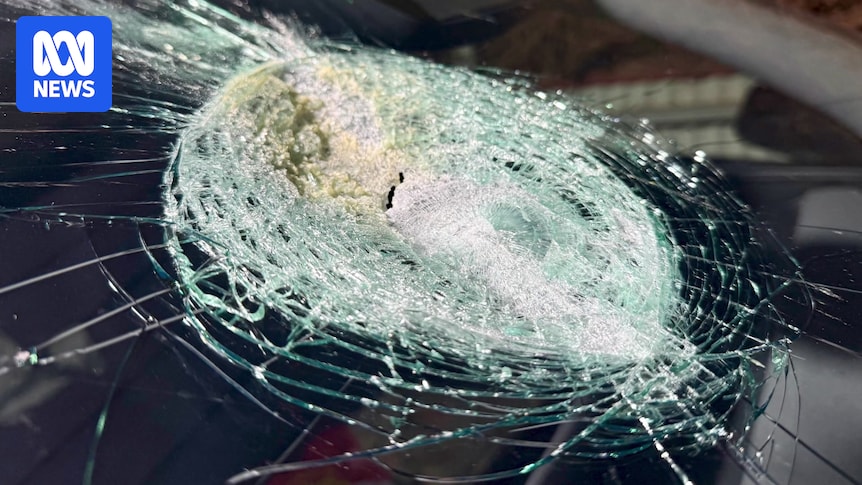Dark mode is here!If you would like to change, tap into the appearance drop down below.Go to appearance
Personalise the news and
stay in the know
Emergency
Backstory
Newsletters
中文新闻
BERITA BAHASA INDONESIA
TOK PISIN
By Rachael Merritt
By George Yankovich
By Angus Randall
Topic:Meteors
Andrew Melville-Smith was left in "shock" after an object which he believes could be a meteorite struck his car. (Supplied: Andrew Melville-Smith)
The SA Museum is investigating whether an object that collided with a car on a regional highway was a meteorite.
The driver was near Port Pirie when an unidentified object smashed and melted part of his windscreen.
Researchers will analyse the windscreen and attempt to find fragments of the object.
Scientists are investigating whether an object that smashed and partially melted a man's car windscreen was a meteorite, in what could potentially be a world-first case of a collision with a moving vehicle.
Whyalla vet Andrew Melville-Smith was travelling along the Augusta Highway, 40 kilometres past Port Germein, when he heard a "loud" and "violent" bang.
"A truck went past — five to 10 seconds later, there was an enormous explosion," Dr Melville-Smith said.
Andrew Melville-Smith with his damaged car. (ABC North & West: George Yankovich)
"Glass went flying inside the car, there was white smoke everywhere, and we could smell burning. My wife thought the car was on fire.
"I thought we'd crashed, it was that loud, it was that violent, it was totally unexpected."
Dr Melville-Smith said he did not see the object strike the windscreen, but was left bleeding and was covered in glass fragments.
He said his car, an electric Tesla set to self-driving mode, did not stop when struck.
"The car was driving along and unconcerned … it wasn't aware of the chaos that was going on in the cabin," he said.
Andrew Melville-Smith says the impact left him bleeding and covered in glass fragments. (Supplied: Andrew Melville-Smith)
He said he initially thought the idea of a meteorite hitting his car was a "load of rubbish" but contacted the South Australian Museum to investigate.
"A lot of people go, 'No way,'" he said.
"[But] offer another explanation — what else melts your windscreen?
"I think I'd have more luck buying a lottery ticket because it is so rare."
The SA Museum's mineralogy assistant collection manager, Kieran Meaney, said that if the object proved to be a meteorite, it would be a world-first case of one hitting a moving vehicle.
He said he was initially hesitant about Dr Melville-Smith's claims, but once he saw the photos, he thought an earthly explanation "didn't add up".
"Andrew's first thought was that it was a bullet, or a stone had been flicked up from a truck, but the police quickly ruled that out," Dr Meaney said.
Kieran Meaney says researchers will analyse the windscreen. (ABC News: Sarah Maunder)
"The really unusual thing is that the glass of his windscreen has actually melted a little bit; there was a lot of heat in whatever hit the windscreen; that's the key thing I can't find a good explanation for.
"It may be the case once we investigate further, we find out it's something different, but at the moment that's the theory we are working with."
Dr Meaney said the team would analyse the windscreen for any debris that became lodged in the glass during the collision, a process which could take weeks or months.
Scientists hope to find fragments of the unidentified object lodged in the windscreen to analyse. (Supplied: Andrew Melville-Smith)
He said they would also investigate whether the object could have been falling space junk or pieces of an old satellite.
"If we do find out that it is a meteorite, we will probably end up going out to where this happened and trying to find the bit of rock."
Andrew Melville-Smith says the sound was so loud he initially thought he had crashed. (ABC North & West: George Yankovich)
Jonti Horner, a professor of astrophysics at the University of Southern Queensland, said he had "good cause" to be sceptical about whether the object was a meteorite, given he had not seen reports of flashes of light.
"Two, three or four minutes before this rock hit the car, there should have been very widely observed across that region a fireball in the sky, at least as bright as a full moon if not significantly brighter," Professor Horner said.
He said small meteorite falls occurred "all the time" in Australia, and there had been examples overseas of meteorites hitting parked cars.
Jonti Horner says the case is a "challenging" one. (University of Southern Queensland: David Martinelli)
He said contrary to what is portrayed in Hollywood films, meteorites are typically cold to the touch by the time they land on Earth.
"That means they have a very thin layer of heat on the outside and a lot of cold on the inside."
Professor Horner said the case was a "challenging" one to piece together, and other potential theories should not be ruled out.
"Maybe it's something that's fallen off an aircraft flying overhead," he said.
"Not saying it isn't a meteorite, I'm just saying there is good cause to be sceptical when it could just be a rock from another source."
Topic:Cancer
Topic:Educational Testing and Examinations
Analysis by David Taylor
Topic:Courts
Topic:Crime
Topic:Meteors
Topic:Meteors
Topic:Meteors
Adelaide
Meteors
Port Augusta
Port Germein
Port Pirie
Road Accidents and Incidents
Space
Whyalla
Topic:Cancer
Topic:Educational Testing and Examinations
Analysis by David Taylor
Topic:Courts
Topic:Crime
Topic:Iron Ore
Topic:Marine Incidents
Topic:Urban Development and Planning
Topic:Urban Development and Planning
We acknowledge Aboriginal and Torres Strait Islander peoples as the First Australians and Traditional Custodians of the lands where we live, learn, and work.
This service may include material from Agence France-Presse (AFP), APTN, Reuters, AAP, CNN and the BBC World Service which is copyright and cannot be reproduced.
AEST = Australian Eastern Standard Time which is 10 hours ahead of GMT (Greenwich Mean Time)












